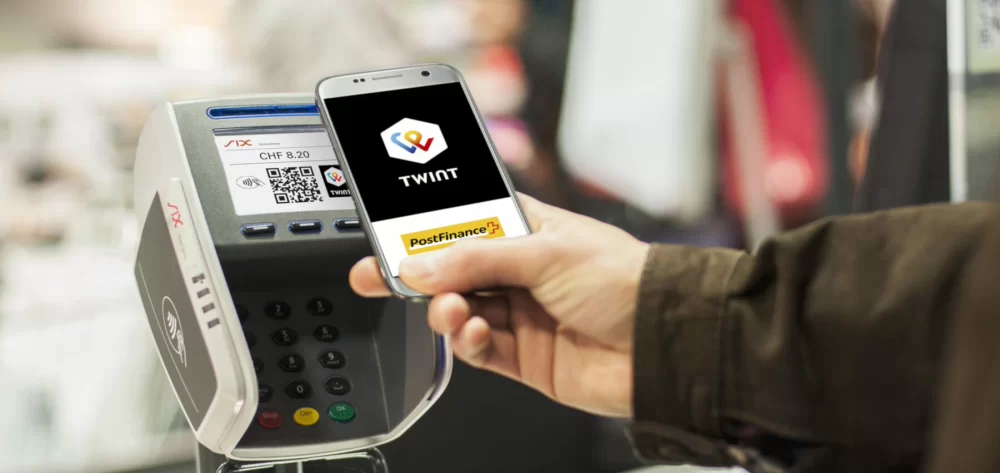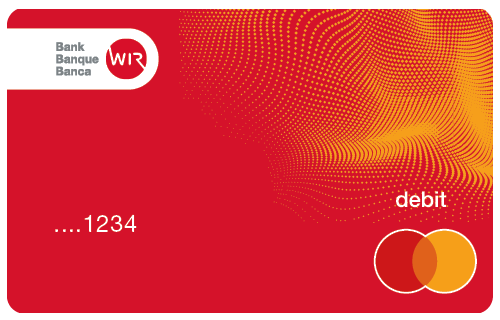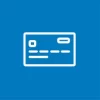The Swiss mobile wallet Twint has been available to consumers in Switzerland for around 10 years now. In this guide, moneyland.ch answers key questions about the Twint mobile wallet.
1. What can Twint do?
You can use the Twint app to:
- Send and receive money
- Make donations to charitable associations
- Pay for purchases at many Swiss online merchants
- Pay for purchases at many Swiss brick-and-mortar merchants
- Withdraw cash at some Swiss brick-and-mortar merchants
- Pay for purchases from many Swiss vending machines
- Pay for parking at many Swiss parking meters
- Pay for purchases at many Swiss farm stalls
The Twint app is especially popular for making and receiving fast money transfers.
Today, Twint offers a variety of functions, including linking customer loyalty cards, redeeming discount coupons, and ordering coffee capsules. You can also use Twint to make buy now pay later purchases at some online stores, with the purchase being charged to your account 30 days after the purchase. Depending on the online store, you may pay an additional fee for the buy now pay later service.
2. Which Twint app should I use?
A common point of confusion is that there are several different Twint apps available. There is a basic, prepaid Twint mobile wallet which can be used independently of any one bank or credit card. Then there are Twint apps which are bank-specific, with different versions offered to customers of different Swiss banks like Credit Suisse, Migros Bank, Postfinance, Raiffeisen, UBS, Valiant, and various cantonal banks. As per March 2024, there are 39 different versions of Twint.
The specialized, bank-specific versions of Twint generally only work in combination with a linked Swiss private account from the specific corresponding bank.
The Twint app offered by UBS is an exception. UBS Twint can be linked to all Swiss credit cards or prepaid cards from any Swiss card issuer.
Depending on your needs, using a bank-specific version of Twint may or may not be advantageous:
- If you want to link Twint directly to your bank account to have purchases or transfers debited directly, using your bank’s Twint app lets you do this.
- If you want to use Twint on a prepaid basis without linking it to a bank account or a credit card, you can do this using the basic prepaid version of Twint.
- If you want to link Twint to your credit card or prepaid card, the UBS Twint app lets you do this.
3. Can I link Twint to my credit card?
Unlike Apple Pay, Google Pay and Samsung Pay, Twint cannot normally be linked to a credit card to have transactions charged directly to your card.
The Twint app offered by UBS is an exception. Even if you do not have a UBS bank account, you can still use the UBS version of Twint by linking a credit card or prepaid card. The only requirement is that you have to use a card issued by a Swiss card issuer.
4. What are the requirements for using Twint?
In order to use Twint, you need a smartphone and a Swiss SIM. The prepaid version of the Twint app also supports phone numbers from Austria, France, Germany, Italy, and Liechtenstein.
To use the basic prepaid version of Twint, you must first identify yourself by capturing an image of your passport or ID card. You also have to take a self-portrait in the Twint app. You can add money to your prepaid Twint balance without identification.
If you want to link Twint to a credit card or prepaid card, you must use a card issued by a Swiss card issuer.
5. Which phones work with Twint?
Twint can be used both on iPhones and on phones which run Android. The only additional requirement is that your phone has a working camera. You do not need an NFC-enabled phone to use Twint, which sets it apart from Apple Pay, Samsung Pay and Google Pay. That means you can use Twint with most phones, including iPhones and phones from Samsung, Huawei, Nokia, Sony and most other phone makers.
6. What are my options if my bank does not have a bank-specific Twint?
Many Swiss banks are Twint partners, but do not offer their own versions of Twint. Examples include Bank Cler and the Basler Kantonalbank. If you bank with a Twint partner bank, you can link your private account to the basic prepaid version of Twint for convenient reloading of your Twint prepaid balance. In this case, your bank account will be charged using a direct debit order.
If your bank is not a Twint partner, you can still use the basic prepaid Twint wallet by reloading your Twint balance at Coop supermarkets and other Twint balance-recharge locations. Alternatively, you can use the UBS Twint app in combination with any Swiss credit card.
7. How do I pay with Twint at stores?
There is more than one way to use Twint to pay at stores.
At most stores, you can pay at standard POS terminals. In this case, you must open the Twint app and scan the QR code displayed on the POS terminal to complete the transaction.
A third option for making payments is using Twint to scan the printed Twint QR codes made available by some Swiss merchants to transfer money to a merchant’s Twint account. This system is widely employed by Swiss farm stalls, with over 1900 farm stalls in Switzerland – including many unmanned farm stalls – accepting this form of Twint payments.
Only very few businesses use Twint Bluetooth beacons. In this case, you have to activate your phone’s Bluetooth connection and open the Twint app to make contactless payments via Bluetooth.
8. Where can I use Twint to pay?
Twint can be used to pay at most Swiss businesses and online stores. Many big Swiss retailers – including Migros, Coop, Denner, Aldi, and Lidl – accept Twint payments at the till. According to Twint, more than 80 percent of all Swiss brick-and-mortar and online merchants accept Twint payments.
9. How do you pay for online shopping using Twint?
To pay with Twint at Swiss online stores which accept it, you must simply scan the QR code displayed on your computer screen during checkout with your phone and the Twint app.
Twint payments are integrated directly into some mobile apps and mobile online stores. The app from the Swiss federal railway SBB/CFF is one example.
10. How do I use Twint to pay for parking?
One of the unique advantages of Twint is that it is accepted at many parking meters located in numerous Swiss municipalities. You can select your parking space from a map in the Twint app, and pay the parking fee directly.
Alternatively, you can also scan the printed QR codes displayed on parking meters that accept Twint. To pay for parking, simply scan the QR code and select the amount of parking time you want to pay for. The first time you use Twint to pay for parking, you will be prompted to enter your car’s license number in the Twint app. If you ever end up needing less parking time than you expected, you can have the unused portion of your parking payment reimbursed in the Twint app so that you only pay for the parking time you actually use.
Twint is also compatible with the automatic license plate recognition systems (using cameras) in some paid parking lots. Once you have activated this feature, you can enter and leave these paid parking lots without having to pay the parking fees at the POS terminal. The parking fees are charged directly via Twint.
11. Where can I load my Twint prepaid balance?
If you use the basic prepaid version of Twint, you can purchase Twint balance credit vouchers at post offices and Coop supermarkets, among others. These can be purchased like gift cards at the till and then scanned using the Twint app to apply the balance credits.
12. How do I send money with Twint?
A major advantage of Twint over Apple Pay, Google Pay and Samsung Pay is that it lets you easily send money to friends, acquaintances and other individuals.
If you send money to someone who uses the basic prepaid version of Twint, the transferred money is credited to the receiver’s prepaid Twint balance. If you transfer money to someone who uses a bank-specific version of Twint, the money is credited to their linked bank account.
You can also use Twint to request money from someone who does not use Twint.
13. Can I withdraw cash with Twint?
In certain shops you can withdraw cash using the Twint app. These stores include, for example, all Volg locations and many kiosks. To withdraw cash, select «Withdraw cash» in the app. You will be given a barcode that you will need to present at the checkout in order to receive your cash.
You can withdraw between 20 and 200 francs. If you withdraw up to 100 francs, you pay a fee of 1 franc. If you withdraw a larger amount, the fee is 1.50 francs.
14. Can I use Twint to pay outside of Switzerland?
No. Twint is a Swiss payment method, and is not accepted outside of Switzerland. Twint is only available to residents of Switzerland.
However, you can use Twint to send and receive money while travelling outside of Switzerland. The Twint app is linked to your phone number, so it can be used for transfers to other Twint users regardless of your geographical location.
Twint is working towards becoming accepted by merchants in other countries like Austria, Belgium, Denmark, Finland, Germany, Norway, Portugal and Sweden. Twint’s strategy is to create two-way partnerships with local mobile payment services in these countries in order to broaden Twint’s acceptance.
15. Do I need an active Internet connection in order to use Twint?
That depends.
In order to make payments using QR codes, you must have an active Internet connection. This can be a mobile data connection, WLAN or any other Internet connection. It is worth noting that many Swiss cafés, restaurants, and other merchants offer complimentary WLAN to customers.
If the store is equipped with a Twint Bluetooth beacon, your phone does not need to have an active Internet connection to make payments.
16. When are transactions debited from my bank account?
If you link Twint directly to your bank account, each purchase or other transaction is debited directly from your bank account. In this way, Twint can be used just like a debit card like a Maestro card or Postfinance debit card.
17. Do I have to authenticate Twint payments?
Yes. A PIN or fingerprint scan is required in order to open the Twint app.
18. What does Twint cost?
Using Twint does not cost anything for you as the Twint user. However, the merchants you buy from are charged fees when you use Twint to pay.
19. Can I earn reward points or cash back with Twint?
Twint does not have its own rewards program or cash back. However, various Swiss rewards programs can be linked to Twint. For example, you can automatically earn Coop Superpoints when you use Twint to pay at Coop stores without a separate Supercard membership card.
You can also copy certain customer loyalty cards (like Cumulus) into the app. You can then scan the relevant code from the Twint app when paying at the cashier or self-checkout, without needing your customer loyalty card or app.
20. How can I protect myself from fraud?
Fraud attempts linked to Twint are becoming increasingly common. The National Cyber Security Centre has asked consumers to be cautious (you can find the announcement here).
Fraudsters try to gain control over a Twint account by getting you to provide personal information like your birthday, Twint PIN, debit card number, or the last five numbers of your IBAN when you pay for something with Twint. If they obtain this information, they can use it to gain access to your Twint account.
Important: You only need to provide your phone number when making a Twint payment. No additional information is necessary. Always observe the security guidelines. You can find more information in the guide to protecting yourself from phishing.
21. What are the advantages of using Twint?
A major advantage of Twint is that it can be used with practically all iPhones and Android-powered phones.
Another advantage is that Twint is a Swiss mobile wallet which is not operated by a foreign tech giant like Google, Samsung or Apple. Unlike foreign mobile wallets, Twint is subject to Swiss privacy laws. According to Twint, users' personal information is only stored in Switzerland.
Twint has another advantage in that it can be used to pay at many Swiss parking meters and at many farm stalls and other small businesses which do not have POS terminals. The ability to send and receive money with Twint is a useful function which is not included in Apple Pay, Google Pay and Samsung Pay.
Twint is also practical for online payments. You do not need to enter your credit card information, but can simply scan the QR code on your computer screen or follow the automatic redirect to the mobile app.
22. What are the disadvantages of Twint?
One disadvantage of Twint is that it has been affected by technical difficulties. It has happened that money was debited from Twint accounts but was not properly transferred to merchants. There have also been cases of delays in money transfers between Twint users.
A major disadvantage of Twint compared to competing mobile wallets is that currently, it can only be used in Switzerland.
The fact that Twint comes in many different versions is confusing, as is the fact that the payment process differs depending on where you use Twint to pay.
Often, you have to open the Twint app first before you can make payments, which feels somewhat unintuitive compared to mobile wallets which are integrated into devices (like Apple Pay). However, you have the option of adding a Twint widget which lets you initiate payments directly from your phone's lock screen.
23. What differentiates Twint from Apple Pay, Google Pay and Samsung Pay?
Unlike Apple Pay, Google Pay and Samsung Pay, Twint cannot currently be used to pay outside of Switzerland.
Technologically, Twint takes a different approach: While Apple Pay, Google Pay and Samsung Pay all rely on NFC technology, Twint’s payment system is based on QR codes and Bluetooth.
Twint offers a number of unique advantages over Apple Pay, Google Pay and Samsung Pay. These include direct linking to Swiss bank accounts, fast money transfers between Twint users, the ability to pay at many Swiss parking meters and farm stalls, and conformity with Swiss privacy laws.
24. How popular is Twint in Switzerland?
In 2023, there were more than five million Twint users who collectively made 590 million transactions. Here are more precise figures:
- 165 million peer to peer transfers between Twint users.
- 255 million Twint payments to brick-and-mortar merchants.
- 170 million Twint payments to online merchants.
More on this topic:
Swiss credit card comparison
Apple Pay FAQ
Google Pay FAQ
Samsung Pay FAQ

 Deal of the Day
Deal of the Day 








